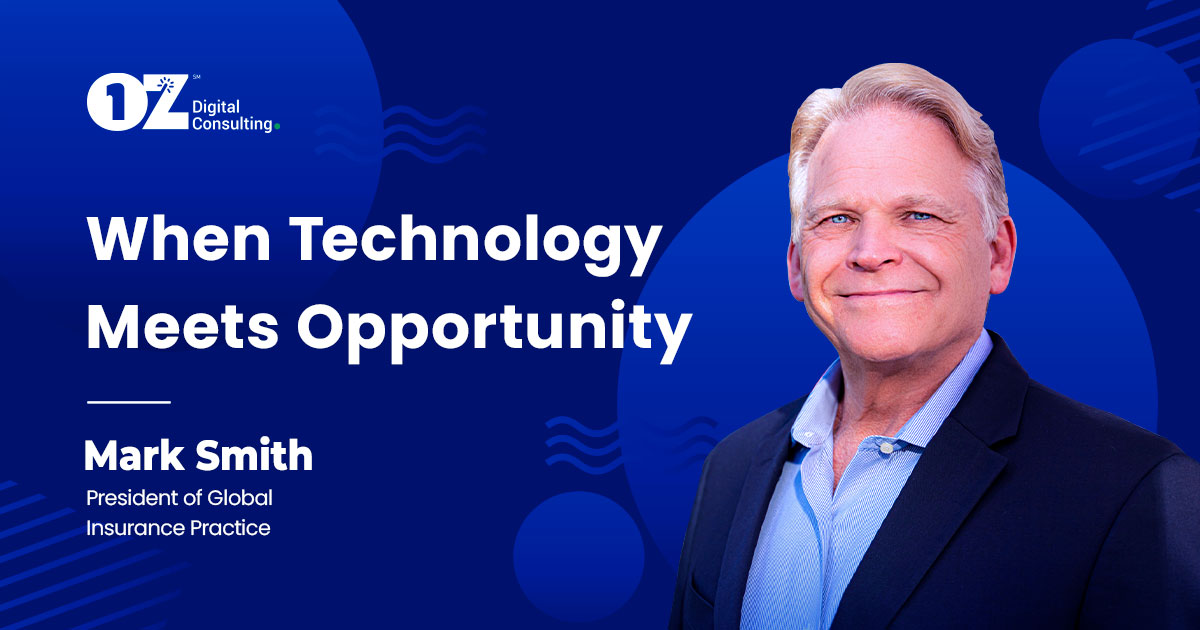A new era of digital transformation is knocking on the insurance industry’s door.
Will it answer?
The ayes here are less equivocal than ever before: According to a Strategy Meets Action study a full 87% of surveyed insurers anticipate substantive changes will come to underwriting over the next five years—a number nearly twenty percentage points higher than in a 2020 survey.
On one hand, it should come as no surprise that modernization and the search for greater efficiencies are a perennial issue for insurance professionals.
After all, insurance is a complex, constantly evolving industry situated within a challenging, (again) constantly evolving regulatory environment.
Yet while other industries transformed data and analytics into customer insights, the same resources in insurance too often got trapped in a traditional underwriting purgatory.
Consider the challenges…
-
- Insurance addresses a wide range of emerging risks, including cyber, changing weather patterns, supply chain bottlenecks, etcetera. This often resulted in silos as insurers launched new products quickly without backward integration into existing platforms.
- Profitability volatility, plus long-term declines in auto ownership, led many carriers to shift from personal auto to multiline offerings. Systems often were stretched beyond their intended use to host disparate insurance programs.
- Creating a single customer view often requires reaching out to eight or more systems—homes, autos, boats, jet skis, art, small business owners, etcetera.
- Underwriters are under intense pressure to respond to brokers, so decisions are made with less-than-optimal information.
- Actuarial and pricing models built on limited data sets and prior results can’t reflect current realities and anticipated issues.
So, then, how to explain the growing optimism that real—and positive—change is coming to insurance?
Well, to paraphrase the great Roman stoic philosopher Seneca’s most enduring maxim—“Luck is what happens when preparation meets opportunity”—the insurance industry’s luck is about to change because technology is about to meet opportunity.
The New (Automation) Deal
Effective transformation doesn’t mean starting from scratch—as more and more CIOs, equipped with ever-more powerful and integrative technologies, are beginning to understand.
In a recent Gartner for IT Executives report entitled, 2022 CIO and Technology Executive Agenda: An Insurance Perspective, for example, notes a fascinating trend in which, rather than being paralyzed by the prospect of completely turning over the entire internal system, many survey respondents indicated they were decreasing legacy system maintenance while simultaneously boosting investment in legacy system modernization and integration.
Some eye-opening numbers from that report:
-
- 41% of insurance respondents reduce spending on maintenance
- 57% increasing investment in legacy application modernization
- 59% increasing investment in integration technologies/APIs/API architecture
Think carefully before replacing systems—particularly if you’ve implemented modifications tailored to your business.
The shift to the cloud often reduces customization because you’re working through APIs, requiring hard thinking about how much you want to standardize.
Augmentation and evolution—say, machine learning that now helps detect fraudulent applications or potential for claims litigation—can reduce the cost of modernization as well as the analysis paralysis and ecosystem-wide disruption that a wholesale gut-and-replace can cause.
The key?
Lean into change management.
Insurers, in concert with the right data integration and automation tools, can become iterative and agile, measuring incremental success and changing culture through action.
The Path Forward
The first priority?
Data.
Its collection, assembly, and location—i.e., where it’s imaged and added.
Fortunately, techniques are available to identify changing customer patterns, evolving risks, product performance, and novel fraud schemes.
These include emerging technologies such as:
-
- Machine learning (ML), can be used to help detect fraudulent applications or potential for claims litigation.
- AI and Natural Language Processing (NLP), can be leveraged to digitize both structured and unstructured data from submission documents and forms.
- Robotic Process Automation (RPA), can be used to search the web, third-party sites, and social media to collect and aggregate data in a digitized for underwriting, actuarial, and pricing models, providing more data and insights about customers and risks. (Read a real-world case study concerning a global P&C insurance company OZ empowered to consolidate data sources with intelligent automation here.)
Leveraging these technologies and Big Data provides a proven path forward for innovation and digital transformation to effectively address the complexities inherent to insurance.
-
- Leverage what you got. Legacy systems can be part of the solution. In many cases, insights-driven digital transformation does not require legacy system replacement. Often Application modernization and API Architecture can provide the foundation for digital transformation.
- Lean into innovation and change management. Insurers can become iterative and agile, measuring incremental success and changing culture through action.
- Have a Strategy. Build a plan that integrates incremental application modernization and digital transformation concurrently—versus one and then the other. Innovation and digital transformation should be the driver—or at least one of the key drivers—for how you modernize your applications.
- Create a “Single Source of Truth.” A single integrated view of the customer often requires reaching out to eight or more systems—homes, autos, boats, jet skies, art, small business owners, and more—as well as distribution partners.
While many have Chief Innovation Officers and departments, data analytics & Insights development, and digital transformation initiatives, many of these investments have not been implemented or have yielded less than the expected outcomes. Largely due to both employee and leadership resistance and the lack of a proven, agile and iterative, repeatable change management process for implementing systems, process, and decision-making changes into their operations.
Many insurance companies begin with programs to automate to increase efficiency. Most P&C insurers (62%) have deployed or are ready to pilot RPA to automate repetitive back-office functions. And the majority think AI will improve operational efficiency (56%).
It’s possible to shift without breaking the system. For example, we commonly see thousands of rules embedded in legacy systems. Even changing just one rule requires having to test everything. By pulling thousands of lines of code and logic out to a rules engine, changes can be made faster and managed with confidence that they won’t break other rules.
What will this look like in practice?
For underwriters, digitized data can be consolidated on an easily accessible dashboard—ideally with links to the actual documents—so that they can make better decisions faster.
Further, such streamlining and processing upgrades can help get underwriters closer to the holy grail of an end-to-end underwriting platform and the “two-question quote,” requiring only the insured’s name plus one other piece of data.
For carriers, digitization makes it easier to fully leverage the power and scope of Big Data, even as they expand the use of third-party data to make underwriting algorithms more effective and profitable.
In short, leveraging technologies designed for integration with existing systems, including APIs and microservices, drives transformation faster than a full administration platform implementation.
Think of it as upgrading the plumbing rather than tearing down the house.
Get the People Part Right
The big challenge is organizational change management.
Companies are either reactive or proactive in leveraging these emergent technologies to transform and innovate, adapting to constantly changing expectations and environments while driving digital transformation.
Insurance companies are accelerating digital business transformation for long-term growth and profitability.
Gartner finds that “the transformation journey is taking large [insurance] enterprises especially at least twice as long and costing twice as much as they originally anticipated.”
Although technology is undoubtedly complicated, it’s less complex than people.
Talented people expect to have the tools they need. Roughly 60% of underwriters said the quality of their organizations’ processes and tools required improvements.
Blended AI and human intelligence is the future.
Successful execution builds trust by developing proven, repeatable processes and following them through implementation. They also need accountable leadership to drive digital transformation, and leading companies are adding chief digital officers to the C-suite.
Separate the Signal from the Noise
Every other industry has pushed data and analytics into customer insights, whereas insurance has applied insights into traditional underwriting.
Few insurers have achieved a 360-degree view of personal or commercial lines customers.
This impacts customer experience at every point. For example, if call center representatives don’t have the complete picture, they can’t recommend the next-best action.
The result?
Another customer opportunity is lost to a static and reactive process.
There’s a two-fold opportunity to use better data analytics:
-
- Push that intelligence back into actuarial and pricing models
- Develop better CX, CLTV, and producer relationships
Nine out of ten insurers expect to increase spending on digital products/services (89%), digital channels to reach customers (88%), and digital self-service options (85%).
These trends will transform the customer experience and competitive landscape over the next few years. Profitability requires a deep understanding of risks and exposures and the ability to raise that business intelligence throughout the underwriting process. Property underwriting requires analytics to uncover “hidden” accumulation of risk from hurricanes and earthquakes.
Lastly, more than committed leadership and agile methodologies may be required. It often makes sense to leverage outside expertise and emerging technology changes so rapidly—e.g., AI, machine learning, natural language processing, and the move to the cloud.
Existing business demands all the resources available. And insurance systems can’t be down for an hour.
With talent at a premium, insurers can leverage outside talent to upskill and move in-house resources forward.
The COVID-19 pandemic accelerated the trend toward digital. Insurance carriers reported a 77% increase in digital underwriting activity and a 76% increase in digital claims volume. The future is digital, and insurers recognize time’s not on their side. The rewards for confidently moving forward will include better outcomes and more satisfied customers.
__
OZ partners with insurers to leverage AI and intelligent workflow solutions for Underwriting, Claims, submissions, call centers, and renewal workflows.
Contact Mark Smith, President of the Global Insurance Practice and Insurance Practice Leader, to discuss how enhanced analytics and Intelligent Automation can enhance profitability and customer experience.



